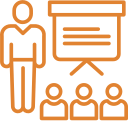Rate this post
The only thing constant in life is change – and in the workplace, things can change constantly. New procedures are created, projects are assigned, employees leave, and acquisitions take place. Being able to cope with change is essential if you want to succeed in the business world. Also, understanding how to harness adaptability and foster resilience through change training is key to thriving amidst disruption. By guiding individuals and teams through the predictable phases of change, leaders can fuel innovation, enhance agility, and create a culture that embraces transformation.



















